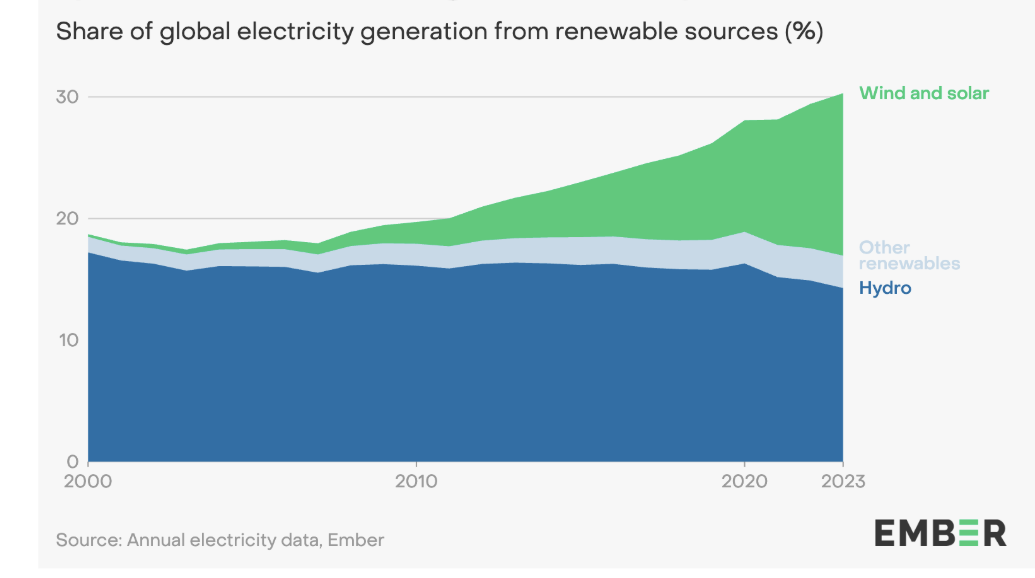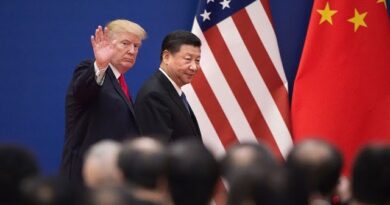Ember Claims Renewable Energy Is Taking Market Share Away From Thermal Generation

Sign up for daily news updates from CleanTechnica on email. Or follow us on Google News!
Ember is a UK-based nonprofit that provides data about renewable energy to clients worldwide. Every year, it publishes a global electricity report that provides a snapshot of where we are and where we are headed when it comes to clean energy. Its report for 2024 has just been released and it contains some good news for renewable energy advocates. Here is the preamble to the report:
“Renewables generated a record 30% of global electricity in 2023, driven by growth in solar and wind. With record construction of solar and wind in 2023, a new era of falling fossil generation is imminent. 2023 was likely the pivot point, marking peak emissions in the power sector.
“The renewables revolution — led by solar and wind — is breaking records and driving ever-cleaner electricity production. The world is now at a turning point where solar and wind not only slow emissions growth, but actually start to push fossil generation into decline [emphasis added]. Indeed, the expansion of clean capacity would have been enough to deliver a fall in global power sector emissions in 2023.
“However, drought caused a five year low in hydropower, which created a shortfall that was met in large part by coal. Nonetheless, the latest forecasts give confidence that 2024 will begin a new era of falling fossil generation, marking 2023 as the likely peak of power sector emissions [emphasis added].”
Renewable Energy Pushing Out Fossil Fuels
Al Jazeera celebrated the latest report from Ember, saying, “Thanks to the galloping pace of new solar and wind capacity, renewables have been claiming almost all growth in electricity demand for five years, leaving fossil fuels stagnant. But this year, they will also roll back fossil fuels’ market share by 2 percent — the beginning of a decade long process of knocking them out of electricity production altogether in three dozen developed economies.”
Renewables expanded by an average of 3.5% a year during the past decade, compared with an annual 1.5% in the previous decade, as prices for photovoltaic panels and wind turbines climbed down and their productivity soared, Ember said.
Several additional factors suggest 2024 will be a turning point, Dave Jones, one of the report’s lead authors, told Al Jazeera. He pointed out that installed capacity underperformed because of light winds and droughts that hobbled hydroelectricity production — conditions that are not expected to continue. “There’s a specific tipping point for 2023 itself. The build-out in solar generation only really happened towards the end of the year and it will only be in 2024 that we’ll see the full force of that build-out reflected in generation.”
In addition to the full year effect of newly installed capacity, Jones said a 50% decrease in solar panel prices in the final months of 2023 will also lead to record new installations. Ember estimates that as a result, renewable generation this year will add a staggering 1,221 Twh of electricity supply, more than double the 513 TWh added last year. “What’s going to happen in 2024 is going to be a next-level renewables boom, which means that for the first time, [the] fossils generation will start falling,” said Jones.
Renewable Energy Boom Spells Trouble For Thermal Generation
Courtesy of Ember
“There’s going to be a bit of a rude awakening on gas,” said Jones. “The gas industry before were really looking forward to coal collapsing because that was going to create a new market for them but actually … wind and solar is replacing coal and it’s replacing gas.”
Ember’s prediction relies on hydroelectric power recovering from five years of drought, and nuclear power continuing to provide just over 9% of the global mix. Europe, which leads the world in clean energy production, could theoretically have progressed even faster if Germany had not decided to shut down its nuclear power plants after Japan’s Fukushima accident in 2011, said Trevelyan Wing, a fellow at Cambridge University’s Center for Geopolitics who focuses on energy matters. But the same forces that shut down nuclear also boosted renewables, he told Al Jazeera.
“The energy transition that’s happening in Germany is in large part because of the anti-nuclear movement. [It] helped launch the citizen energy movement, which has installed solar and wind farms, biogas plants, and really made possible the near-exponential expansion of renewable energy there.”
The Yin & Yang Of Renewable Energy In China
China plays an outsized role on both sides of the energy transition story. Last year it created about 29% of the world’s greenhouse gas emissions — twice that of the the United States. But it also installed half the world’s solar panels and 60% of the world’s wind turbines, easily making it the green energy transition leader. It also manufactures as much as 85% of the solar panels the rest of the world installs, although it must be pointed out that some critics believe some Chinese solar panel manufacturers rely on electricity from thermal generation — primarily coal.
China is also a leader in the electrification of transport and heating, two of the most polluting sectors of the economy after electricity production. Last year it put more electric vehicles on the road and heat pumps into homes than the rest of the world combined, and was responsible for almost all new electricity demand. According to Ember, “China’s need to find new export markets is a tremendous opportunity for countries around the world to take advantage of how cost competitive and available solar is compared to other generation sources.”
Biden Administration Prepares To Act
But not everyone is happy with China’s state-led model of renewables development. “Right now the very broad spread of renewables, and especially solar, is partly based on the very large subsidies China is giving to photovoltaic infrastructure,” energy analyst Miltiadis Aslanoglou told Al Jazeera. “Its goal is to dominate and wipe any competitors off the map so that in the coming years it will have a technology monopoly.”
The European Union and the US, leading markets for Chinese photovoltaics, are both beneficiaries and victims, Aslanoglou said. “The accusation is that all the added value being created in China is at the expense of [what would be] a competitive market in renewables for everyone else, due to all the state subsidies being given.”
Indeed, the Biden administration is expected to announce new tariffs on many Chinese-made products — especially electric vehicles — next week, according to Bloomberg. Whether new tariffs will also apply to solar panels is unclear at this moment. Biden has paused higher tariffs on Chinese-made solar panels until now, a move that has sorely troubled US solar panel manufacturers. The US is faced with a Hobson’s choice — gorge on cheap Chinese-made cars and solar panels because they help advance positive climate goals, or slam them with high tariffs to protect domestic manufacturers.
Aslanoglou said tariff policies could have knock-on effects across a broad range of industries. A surge in solar panel installations could leave electrical grids unprepared to carry increasing loads. They also could up-end the business plans of for new methane terminals, pipelines and distribution networks, which require decades to recoup investments. It isn’t easy being green.
Nikos Tsafos, chief energy adviser to Greek Prime Minister Kyriakos Mitsotakis, believes the environment must come first. “What we know is that in most countries renewables are the cheapest way to produce new energy,” he told Al Jazeera. “For a country like Greece, which imports fossil fuels, renewables are cheaper and more reliable, and that creates a dynamic that is almost unstoppable.”
Under Mitsotakis, Greece has transitioned quickly, producing 57% of its electricity from renewables last year, and aiming to produce 80% by the end of the decade. For Greece, which once imported almost all of its energy, that means security of supply and price stability and promoting what it hopes will be an economic comeback from its 2010 bankruptcy in the coming decade.
Tsafos believes Europe has finally arrived at a very desirable problem, which is how to absorb the clean electricity it generates. “We have hours when renewables have zero market value,” Tsafos said. “The question is no longer whether renewables are competitive, but how to reform the system to absorb them. Some companies will close, others will spring up. The energy transition is inevitable and not something you should delay or something you can prevent. If something creates a new dependence, you have to manage the trade-offs.”
The Takeaway
Creative destruction is a primary tenet of capitalist theory. It suggests that innovation will constantly make the allocation of capital more efficient, but the corollary to that is that some businesses that are successful today will be pushed out of the marketplace. The iPhone versus Blackberry is perhaps the clearest recent example of creative destruction in action. Electric cars seem poised to do the same to established automakers.
Fossil fuel executives should be terrified by the latest news from Ember. In the example above, they are Blackberry and renewable energy is the iPhone. We need creative destruction of the fossil fuel industry if the Earth is to have any hope of not overheating to the point where most humans can no longer survive. Ember suggests that process had begun. But will renewable energy replace thermal generation fast enough to make a difference? That is a question that won’t be fully answered until many decades from now.
Hat tip to Dan Allard.
Have a tip for CleanTechnica? Want to advertise? Want to suggest a guest for our CleanTech Talk podcast? Contact us here.
Latest CleanTechnica.TV Video

Advertisement
CleanTechnica uses affiliate links. See our policy here.




